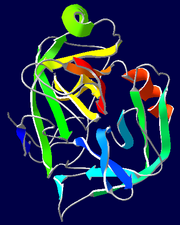Cancer's Best Medicine, a 48-page booklet by Mauris L. Emeka, explains what cancer cells need in order to thrive and, conversely, what kind of environment will inhibit their growth. A deficiency of pancreatic enzymes, specifically trypsin and chymotrypsin, encourages cancer growth, according to the work of Scottish embryologist John Beard. Beard discovered almost a hundred years ago that these protein-digesting enzymes prevent undifferentiated trophoblast cells from growing unchecked and forming tumors. Unlike fresh raw food, processed food contains no digestive enzymes. People who eat mostly processed food and a lot of animal protein risk overworking the pancreas and depleting their supply of enzymes. Emeka suggests eating enzyme-rich raw fruits, especially papaya and pineapple, and, perhaps, taking pancreatin as a supplement.
A deficiency of pancreatic enzymes is only part of the puzzle; oxygen and acidity are another part. Cancer cells, unlike normal cells, thrive in a low-oxygen, acidic environment--and they love simple sugars. Dr. Otto Warburg discovered that cellular oxygen is a key factor in preventing cancer. Healthy cells only use anaerobic metabolism (cancer's preferred way to make energy) when cellular oxygen levels become low. During anaerobic metabolism, lactic acid forms, creating an inviting acidic terrain for cancer growth. With abundant cellular oxygen levels, normal cells create energy more efficiently and maintain a healthy pH level. In his self-help booklet, Emeka recommends eating plenty of dark green leafy vegetables (i.e., collard greens, turnip greens, kale, and Swiss chard) each day. The high chlorophyll content in these vegetables "enhances the circulation of oxygen at the cellular level and it contributes greatly to normalizing body pH by making it less acidic and more alkaline." Drinking plenty of water and a practice of deep breathing and physical exercise also bring more oxygen into the body.
In addition to these recommendations, Cancer's Best Medicine suggests specific foods and other simple lifestyle actions that promote health and stimulate the immune system. Emeka urges patients to remember that while "cancer is a serious health condition ... cancer is not your life, it is not the essence of who you are." Cancer's Best Medicine is available from Apollo Publishing International, P.O. Box 1937, Port Orchard, Washington 98366 (phone 360-876-5376) for $6.00. Emeka, Mauris L. Cancer's Best Medicine--A Self-Help and Wellness Guide (Apollo Publishing International, 2004)
COPYRIGHT 2005 The Townsend Letter Group
COPYRIGHT 2005 Gale Group



